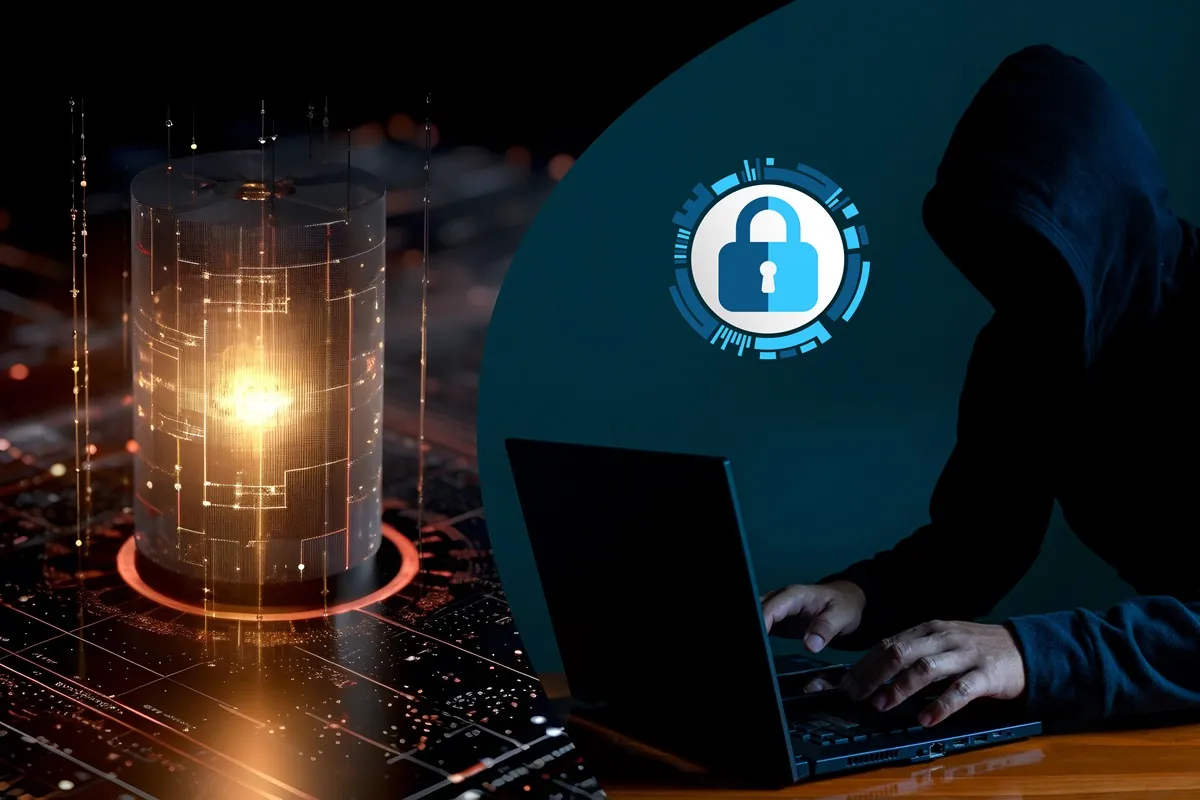Imagine a future where computers can solve problems that are currently impossible for our most powerful supercomputers. This future is not science fiction; it’s the promise of quantum computing.
While this technology holds immense potential for scientific breakthroughs and technological advancements, it also poses a significant threat to our current cybersecurity infrastructure.
Quantum computers leverage the principles of quantum mechanics to perform calculations in a fundamentally different way than traditional computers. Instead of using bits, which can be either 0 or 1, quantum computers use qubits, which can exist in multiple states simultaneously.
This unique property allows quantum computers to process information exponentially faster than classical computers.
However, this incredible power has a dark side. Quantum computers could potentially break the encryption algorithms that currently protect our sensitive data.
These algorithms, such as RSA and ECC, are based on mathematical problems that are extremely difficult for classical computers to solve. But quantum computers, armed with algorithms like Shor’s algorithm, could efficiently crack these problems, rendering our current encryption methods obsolete.
This poses a serious threat to our digital world. Hackers could potentially intercept and store encrypted data today, waiting for the advent of powerful quantum computers to decrypt it later.
This “harvest now, decrypt later” attack could compromise sensitive information, such as financial records, medical data, and national security secrets.
To address this looming threat, it is crucial to start preparing for the quantum era now. By understanding the risks and taking proactive measures, we can safeguard our digital future.
The Threat to Cybersecurity
As we’ve discussed, quantum computers offer immense computational power, but this power can be harnessed for malicious purposes.
One of the most significant threats posed by quantum computers is their ability to break the encryption algorithms that currently secure our digital world.
Traditional encryption methods rely on complex mathematical problems that are incredibly difficult for classical computers to solve. For example, RSA encryption, widely used for secure communication, relies on the difficulty of factoring large numbers.
Similarly, elliptic curve cryptography (ECC) is based on the difficulty of solving the discrete logarithm problem.
However, quantum computers, armed with algorithms like Shor’s algorithm, can efficiently solve these problems. Shor’s algorithm can factor large numbers exponentially faster than classical algorithms, effectively breaking RSA encryption.
This means that data encrypted today could be easily decrypted in the future when powerful quantum computers become a reality.
Unlocking Business Growth with 24-Hour Support: What the Data Tells Us
The implications of this are far-reaching. Hackers could intercept and store encrypted data today, waiting for the advent of powerful quantum computers to decrypt it later.
This “harvest now, decrypt later” attack could compromise sensitive information, such as financial records, medical data, and national security secrets.
To mitigate this threat, it’s essential to start preparing for the quantum era now. By understanding the risks and taking proactive measures, we can safeguard our digital future.
Understanding the Quantum Threat
To delve deeper into the quantum threat, we need to understand the fundamental principles behind quantum computing and the specific algorithms that pose a risk to our current security infrastructure.
At the heart of quantum computing lies the qubit, the quantum equivalent of a classical bit. Unlike classical bits, which can be either 0 or 1, qubits can exist in a superposition of states, meaning they can be 0, 1, or both simultaneously.
This property allows quantum computers to perform multiple calculations in parallel, significantly accelerating certain types of computations.
One of the most powerful quantum algorithms is Shor’s algorithm. This algorithm can efficiently factor large numbers, a task that is incredibly difficult for classical computers. As mentioned earlier, many encryption algorithms, including RSA, rely on the difficulty of factoring large numbers.
By breaking down these large numbers into their prime factors, Shor’s algorithm can effectively crack the encryption, compromising the security of our digital systems.
Another quantum algorithm that poses a threat is Grover’s algorithm. While not as powerful as Shor’s algorithm, Grover’s algorithm can significantly speed up the process of searching through unsorted databases.
This could have implications for brute-force attacks, where attackers attempt to guess passwords or encryption keys by trying all possible combinations.
By understanding the capabilities of quantum computers and the specific algorithms that pose a threat, we can begin to develop strategies to mitigate these risks.
Preparing for the Quantum Leap
As the quantum computing era approaches, organizations must take proactive steps to safeguard their sensitive information. One crucial aspect of this preparation is assessing the organization’s risk exposure to quantum attacks.
Assessing Your Organization’s Risk
The first step involves identifying critical data and systems that could be compromised by a quantum attack. This includes sensitive information such as financial records, intellectual property, and customer data.
Organizations should evaluate the potential impact of a successful quantum attack, considering factors such as financial loss, reputational damage, and legal liabilities.
Once the organization’s risk profile is assessed, it’s essential to prioritize the protection of critical assets. This may involve implementing additional security measures, such as stronger access controls and network security protocols.
Transitioning to Quantum-Resistant Cryptography
To ensure long-term security, organizations must transition to quantum-resistant cryptographic algorithms. These algorithms are designed to withstand attacks from both classical and quantum computers.
The National Institute of Standards and Technology (NIST) is leading the standardization process for quantum-resistant cryptography. NIST has selected several promising algorithms that are expected to become the future standard for secure communication.
The transition to quantum-resistant cryptography involves several steps, including:
- Inventorying current cryptographic systems: Identifying all cryptographic systems used within the organization.
- Selecting appropriate quantum-resistant algorithms: Choosing algorithms that are suitable for the organization’s specific needs.
- Developing a migration plan: Creating a detailed plan for the gradual replacement of existing cryptographic systems with quantum-resistant alternatives.
- Implementing new cryptographic systems: Deploying the selected quantum-resistant algorithms across the organization’s infrastructure.
Quantum Key Distribution (QKD)
Quantum Key Distribution (QKD) is a secure communication method that leverages the principles of quantum mechanics to exchange cryptographic keys.
Unlike traditional key exchange methods, QKD is fundamentally secure, as any attempt to eavesdrop on the communication would inevitably disturb the quantum state of the photons, alerting the sender and receiver to the intrusion.
While QKD offers a high level of security, it has certain limitations, including the need for dedicated fiber-optic networks and the relatively short distances over which keys can be distributed.
As a result, QKD is best suited for high-security applications, such as government and financial institutions.
The Future of Cybersecurity
As we navigate the rapidly evolving landscape of technology, the future of cybersecurity is inextricably linked to the advancement of quantum computing.
While quantum computers hold immense potential for scientific breakthroughs, they also pose significant risks to our current security infrastructure.
To address these challenges, organizations must adopt a forward-thinking approach that embraces emerging technologies and international collaboration.
Quantum-Safe Hardware and Software
One crucial aspect of future-proofing our digital infrastructure is the development of quantum-safe hardware and software. This involves designing systems that are resistant to attacks from both classical and quantum computers.
By incorporating quantum-resistant cryptographic algorithms into hardware and software, organizations can protect their sensitive data from the potential threats of quantum computing.
Quantum-Safe Network Protocols
Secure network communication is essential for protecting sensitive data. Quantum-safe network protocols are designed to withstand the power of quantum computers.
These protocols utilize advanced cryptographic techniques that are resistant to quantum attacks, ensuring the confidentiality and integrity of data transmitted over networks.
The Role of AI and Machine Learning
Artificial intelligence and machine learning have the potential to revolutionize the field of cybersecurity. By leveraging AI-powered tools, organizations can automate threat detection, incident response, and vulnerability assessment processes.
Machine learning algorithms can analyze vast amounts of data to identify patterns and anomalies, enabling early detection of cyberattacks.
Furthermore, AI can be used to develop sophisticated defense mechanisms, such as adaptive security systems that can learn and adapt to evolving threats. By harnessing the power of AI and machine learning, organizations can stay ahead of cybercriminals and protect their digital assets.
International Cooperation and Standards
The global nature of cyber threats necessitates international cooperation and standardization. By working together, countries can share information, coordinate efforts, and develop common standards for cybersecurity.
International collaboration is essential for addressing the complex challenges posed by quantum computing and other emerging technologies.
By fostering international cooperation, we can establish a unified framework for cybersecurity, ensuring that organizations worldwide are equipped to defend against cyberattacks. Sources and related content
Conclusion
The advent of quantum computing marks a significant turning point in the history of technology. While this powerful technology holds immense potential for scientific discovery and technological advancement, it also presents a serious threat to our current cybersecurity infrastructure.
The ability of quantum computers to break traditional encryption algorithms could have far-reaching consequences for individuals, organizations, and nations alike.
To safeguard our digital future, it is imperative to take proactive measures to prepare for the quantum era. By understanding the risks, assessing our organization’s vulnerability, and implementing quantum-resistant security solutions, we can mitigate the potential impact of quantum attacks.
It is crucial to stay informed about the latest developments in quantum computing and cybersecurity. By following industry news, attending conferences, and participating in online forums, organizations can stay ahead of the curve.
Additionally, fostering collaboration with other organizations and cybersecurity experts can help share knowledge and best practices.
As we embark on this quantum leap, it is essential to embrace innovation and adopt a forward-thinking approach to cybersecurity. By taking decisive action now, we can secure our digital future and protect our sensitive information from the quantum threat.



